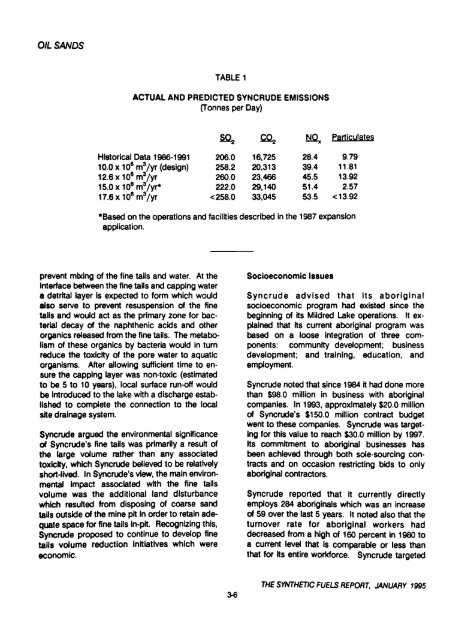Ikelic - Alliance Digital Repository
Ikelic - Alliance Digital Repository
Ikelic - Alliance Digital Repository
You also want an ePaper? Increase the reach of your titles
YUMPU automatically turns print PDFs into web optimized ePapers that Google loves.
OIL SANDS<br />
TABLE 1<br />
ACTUAL AND PREDICTED SYNCRUDE EMISSIONS<br />
Historical Data 1986-1991<br />
10.0 x106m3/yr (design)<br />
12.6x106m3/yr<br />
15.0x106m3/yr*<br />
17.6x106m3/yr<br />
(Tonnes per Day)<br />
SO, CO, NS, Particulates<br />
206.0 16,725 28.4 9.79<br />
258.2 20,313 39.4 11.81<br />
260.0 23,466 45.5 13.92<br />
222.0 29,140 51.4 2.57<br />
< 258.0 33,045 53.5 < 13.92<br />
Based on the operations and facilities described in the 1987 expansion<br />
application.<br />
prevent mixing of the fine tails and water. At the<br />
interface between the fine tails and capping water<br />
a detrital layer is expected to form which would<br />
also serve to prevent resuspension of the fine<br />
tails and would act as the primary zone for bac<br />
terial decay of the naphthenic acids and other<br />
organics released from the fine tails. The metabo<br />
lism of these organics by bacteria would in turn<br />
reduce the toxicity of the pore water to aquatic<br />
organisms. After allowing sufficient time to en<br />
sure the capping layer was non-toxic (estimated<br />
to be 5 to 10 years), local surface run-off would<br />
be Introduced to the lake with a discharge estab<br />
lished to complete the connection to the local<br />
site drainage system.<br />
Syncrude argued the environmental significance<br />
of Syncrude's fine tails was primarily a result of<br />
the large volume rather than any associated<br />
toxicity, which Syncrude believed to be relatively<br />
short-lived. In Syncrude's view, the main environ<br />
mental impact associated with the fine tails<br />
volume was the additional land disturbance<br />
which resulted from disposing<br />
of coarse sand<br />
tails outside of the mine pit in order to retain ade<br />
quate space for fine tails in-pit. Recognizing this,<br />
Syncrude proposed to continue to develop fine<br />
tails volume reduction initiatives which were<br />
economic.<br />
3S<br />
Socioeconomic Issues<br />
Syncrude advised that its aboriginal<br />
socioeconomic program had existed since the<br />
beginning<br />
of its Mildred Lake operations. It ex<br />
plained that its current aboriginal program was<br />
based on a loose integration of three com<br />
ponents: community development; business<br />
development; and training, education, and<br />
employment.<br />
Syncrude noted that since 1984 it had done more<br />
than $98.0 million in business with aboriginal<br />
companies. In 1993, approximately $20.0 million<br />
of Syncrude's $150.0 million contract budget<br />
went to these companies. Syncrude was target<br />
ing for this value to reach $30.0 million by 1997.<br />
Its commitment to aboriginal businesses has<br />
been achieved through both soie-sourcing con<br />
tracts and on occasion restricting bids to only<br />
aboriginal contractors.<br />
Syncrude reported that it currently directly<br />
employs 284 aboriginals which was an increase<br />
of 59 over the last 5 years. It noted also that the<br />
turnover rate for aboriginal workers had<br />
decreased from a high of 160 percent in 1980 to<br />
a current level that is comparable or less than<br />
that for its entire workforce. Syncrude targeted<br />
THE SYNTHETIC FUELS REPORT, JANUARY 1995















![pace SrntfletIc fne]its report - Alliance Digital Repository](https://img.yumpu.com/10493335/1/190x245/pace-srntfletic-fneits-report-alliance-digital-repository.jpg?quality=85)
